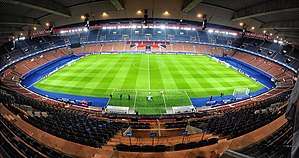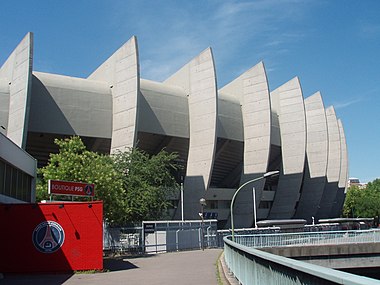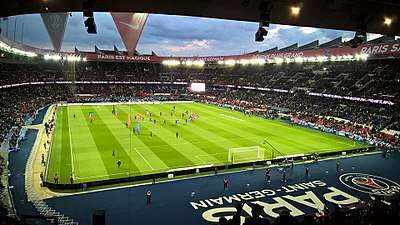Parc des Princes
The Parc des Princes (French pronunciation: [paʁk de pʁɛ̃s], literally "Princes’ Park" in English) is an all-seater football stadium in Paris, France.[1] The venue is located in the south-west of the French capital, inside the 16th arrondissement of Paris, in the immediate vicinity of the Stade Jean-Bouin (rugby venue) and within walking distance from the Stade Roland Garros (tennis venue).[1][2]
 | |
 UEFA | |

| |
| Location | 24, Rue du Commandant-Guilbaud 75016 Paris, Île-de-France, France |
|---|---|
| Coordinates | 48°50′29″N 2°15′11″E |
| Public transit | |
| Owner | Paris City Council |
| Operator | Paris Saint-Germain |
| Capacity | 47,929 |
| Record attendance | 50,370 (Rugby: France vs Wales, 18 February 1989) |
| Field size | 105 m × 68 m (344 ft × 223 ft) |
| Surface | GrassMaster by Tarkett Sports |
| Construction | |
| Built | 1967 (current) |
| Opened | 25 May 1972 |
| Renovated | 1997–1998, 2014–2016 |
| Construction cost | 150 million FRF (1972) |
| Architect | Roger Taillibert & Siavash Teimouri |
| Tenants | |
| Paris Saint-Germain (1974–present) | |
The stadium, with a seating capacity of 47,929 spectators, has been the home of Paris Saint-Germain since 1974.[3][4] Before the opening of the Stade de France in 1998, it was also the home arena of the French national football and rugby union teams.[4] The Parc des Princes pitch is surrounded by four covered all-seater stands, officially known as Tribune Borelli, Tribune Auteuil, Tribune Paris and Tribune Boulogne.[5]
Conceived by architect Roger Taillibert & Siavash Teimouri, the current version of the Parc des Princes officially opened on 25 May 1972, at a cost of 80–150 million francs.[6][7] The stadium is the third to have been built on the site, the first opening its doors in 1897 and the second following in 1932.[2]
PSG registered its record home attendance in 1983, when 49,575 spectators witnessed the club's 2–0 win over Waterschei in the UEFA Cup Winners' Cup quarter-finals.[8] However, the French national rugby team holds the stadium's absolute attendance record. They defeated Wales 31–12 in the 1989 Five Nations Championship in front of 50,370 spectators.[9]
History
Original stadium (1897–1932)
Originally called Stade Vélodrome du Parc des Princes, the stadium was inaugurated on July 18, 1897. Situated in the 16th arrondissement of Paris, the area was a forested parkland used by the royal family before the French Revolution. This gave Parc des Princes its name.[7][10]

With more than 3,000 seats, the velodrome had a 728-yard track.[7][10] The director of the stadium, Henri Desgrange, was a former racing cyclist and founder of the cycling magazine L'Auto (predecessor of L'Équipe).[10] Le Parc marked the finish of the Tour from its first edition in 1903 until 1967.[4] The 1900 UCI Track Cycling World Championships was held at Parc des Princes.[10]
In 1903, an English side easily defeated a team composed by the best Parisian players (11–0) in front of 984 paying spectators, in what was the first international football played at the Parc des Princes.[7] In 1905, the French national football team contested its first ever home match against Switzerland, winning 1–0 at le Parc.[7][10] Subsequently, the stadium welcomed further prestigious friendly games, but also four USFSA French championship finals, as well as the 1919 Coupe de France Final between CASG Paris and Olympique de Paris in front of 10,000 spectators.[7]
PSG's home also boasts a long history as an international rugby venue.[2] In 1906, the French national rugby union team played their first international against the New Zealand national rugby union team. Other tenants included the Racing Club de France.[10]
The stadium capacity was increased to 20,000 by the start of the 1924 Summer Olympics, held in Paris. However, Stade Olympique Yves-du-Manoir, which had been expanded to 60,000 seats, hosted the event.[10]
Second stadium (1932–1972)

In the 1930s, L'Auto founder Henri Desgrange and his business partner Victor Goddet carried out a thorough reconstruction of Parc des Princes and expanded it so that the sports arena had seats for 45,000 visitors, including 26,000 covered.[7][10] The new stadium opened on April 19, 1932.[2][7] Its capacity, however, was quickly reduced to 38,000 seats to improve comfort.[7] Le Parc hosted the opening match of the 1938 FIFA World Cup between Switzerland and Germany as well as the victory of Hungary in the semi-final against Sweden. But Stade Olympique Yves-du-Manoir continued to be more important, hosting the 1938 FIFA World Cup Final in which Italy beat the Hungarians 4–2 to claim its second consecutive world title.[10]
Following the Liberation of Paris in August 1944 and the end of World War II in September 1945, the French football championship returned, with big Parisian clubs Stade français-Red Star and Racing Paris regularly playing at the Parc des Princes. Still equipped with a cycling track of 454 metres, the Tour de France was not the only major sporting event hosted at this stadium.[4][7] Le Parc also hosted the 1954 Rugby League World Cup Final, which saw Great Britain defeat hosts France in the inaugural staging of the Rugby League World Cup;[11] Real Madrid's win over Stade de Reims in the first ever European Cup final in 1956;[4] and the 1960 European Nations' Cup Final, which saw the Soviet Union claim the first edition of the tournament after beating Yugoslavia.[2]
Current stadium (since 1972)
Design
Conceived by French architect Roger Taillibert and Iranian artist Siavash Teimouri, the design of the third and current Parc des Princes was innovative for the time, allowing spectators to enjoy excellent sight-lines, with no seat being further than 45 metres from the pitch.[1][10] It was also the first stadium with lighting systems integrated onto its elliptical roof, and to this day is praised for its unique acoustics and its distinctive concrete ribs or razors.[1]

Described in French as a 'caisse de résonnance' ('box of sound') due to its tight dimensions and the pressure-cooker atmosphere created by its home fans, it is one of the continent's most emblematic and historic venues.[4][10] Its raw concrete exterior may not be as extraordinary today, in the era of multimedia stadiums. But the razors supporting the concrete shell remain an icon of local skyline and the structure has aged with grace. It is a landmark and legally protected icon of French architecture.[12]
Furthermore, the seating bowl provides two continuous tiers without obstructed views, though some obstructions were introduced due to additional fencing of the away enclosure. Distance of end zones from the field is a disadvantage, because the stadium was designed with rugby in mind and left too much room for a football configuration.[12]
Opening and PSG
The inauguration of the Parc des Princes took place on 25 May 1972 on the occasion of the football match between France and USSR. The new stadium hosted the 1972 Coupe de France Final between Olympique de Marseille and Bastia on June 4, 1972.[7][10] That same year, Paris Saint-Germain (PSG) – a fusion between Paris Football Club (PFC) and Stade Saint-Germain – went through a bitter divorce. Paris FC remained in Ligue 1, while PSG kept their name but were administratively demoted to Division 3.[13][14]
PSG played their first game at the Parc des Princes against Ligue 2 promotion rivals Red Star on 10 November 1973, as a curtain-raiser for that season's league season between PFC and Sochaux. PSG won 3–1 as Othniel Dossevi scored the club's first goal at the stadium.[15] PSG returned to Ligue 1 in 1974, ironically the same year that Paris FC (PFC) were relegated. They immediately moved into the Parc des Princes, which up until that point had been the home stadium of PFC.[13][14] Before that, PSG had been playing at several grounds including the Stade Municipal Georges Lefèvre, the Stade Jean-Bouin, the Stade Bauer, and even the Parc des Princes a few times that season despite the reluctance of PFC.[16][17] Thereafter, Paris FC and Racing Paris also played at Parc des Princes while they were in Ligue 1 (until 1990), but never reaching the numbers of attendance leaders PSG.[7]
Following its opening, Parc des Princes finally became France's biggest stadium.[10] This was where the national and international cup finals took place, including every single Coupe de France from 1972 to 1997, and three European club finals: the 1975 European Cup Final, the 1978 European Cup Winners' Cup Final and the 1981 European Cup Final.[2][10] Most importantly, le Parc saw France defeat Spain in the UEFA Euro 1984 Final to claim its first-ever title. In 1992, France was named to host the 1998 World Cup. It was the country's first since 1938 and construction of a new arena began in May 1995, at the same time that Parc des Princes hosted the 1995 UEFA Cup Winners' Cup Final.[10]

Inaugurated in January 1998, Stade de France was the stadium of the future, while le Parc hosted its last international final that same year: the 1998 UEFA Cup Final.[10] Les Bleus have only played twice at Parc des Princes since 1998: against Scotland during the UEFA Euro 2008 qualifiers in September 2007, and versus Australia in a friendly match in October 2013.[18] Nonetheless, the stadium has still staged games at the 1998 FIFA World Cup, 2007 Rugby World Cup, UEFA Euro 2016 and 2019 FIFA Women's World Cup.[2][4]
Renovation and expansion
In November 2013, PSG reached an agreement with the Paris City Council, owner of Parc des Princes, to extend their stadium lease for a further 30 years until 2043, based on a fixed rent plus a variable share of their income.[10][19][20] Subsequently, under the guidance of American architect Tom Sheehan, PSG completed a three-year €75 million upgrade of the Parc des Princes (2012, 2013–2014, 2015–2016) ahead of the UEFA Euro 2016 in France.[12][20]
Two additional rows of seats were added, allowing the ground to remain at a capacity of 48,000, despite now boasting larger and more comfortable seats.[20] Hospitality capacity went from 1,200 to 4,500, and new substitutes' benches and spacious, modern changing rooms that include warm-up and treatment rooms were installed.[4][20] Carrying out this renovation work saw PSG's stadium revenue swell from €20m to €100m.[20]
PSG are also looking to increase the capacity of their home to 60,000 in the coming years.[20] From the start of their ownership at the capital club, Qatar Sports Investments (QSI) made it clear that a larger stadium is one of the means to establish PSG as one of leading European clubs. Originally, there were two options under consideration: move to the Stade de France or expand Parc des Princes. The former was discarded following the redevelopments made to le Parc ahead of the Euro 2016. Expansion before the tournament proved impossible, but according to PSG deputy CEO Jean-Claude Blanc the club's plans have not changed.[21] There have also been rumours that QSI are interested in buying Parc des Princes for a fee believed to be around €150m.[10]
Major tournament matches
1938 FIFA World Cup matches
| Date | Time (WEST) | Team #1 | Result | Team #2 | Round | Spectators |
|---|---|---|---|---|---|---|
| 4 June 1938 | 17:00 | 1–1 (a.e.t.) | First Round | 27,152 | ||
| 9 June 1938 | 18:00 | 2–4 | First Round replay | 20,025 | ||
| 16 June 1938 | 18:00 | 5–1 | Semi-finals | 20,000 |
1954 Rugby League World Cup matches
| Date | Time (CET) | Team #1 | Result | Team #2 | Round | Spectators |
|---|---|---|---|---|---|---|
| 30 October 1954 | 22–13 | First round | 13,240 | |||
| 13 November 1954 | 12–16 | Final | 30,368 |
1960 European Nations' Cup matches
| Date | Time (CET) | Team #1 | Result | Team #2 | Round | Spectators |
|---|---|---|---|---|---|---|
| 6 July 1960 | 20:00 | 4–5 | Semi-finals | 26,370 | ||
| 10 July 1960 | 21:30 | 2–1 (a.e.t.) | Final | 17,966 |
1972 Rugby League World Cup matches
| Date | Time (CET) | Team #1 | Result | Team #2 | Round | Spectators |
|---|---|---|---|---|---|---|
| 1 November 1972 | 9–5 | First round | 8,000 |
UEFA Euro 1984 matches
| Date | Time (CEST) | Team #1 | Result | Team #2 | Round | Spectators |
|---|---|---|---|---|---|---|
| 12 June 1984 | 20:30 | 1–0 | Group 1 | 47,570 | ||
| 20 June 1984 | 20:30 | 0–1 | Group 2 | 47,691 | ||
| 27 June 1984 | 20:00 | 2–0 | Final | 47,368 |
1991 Rugby World Cup matches
| Date | Time (CEST) | Team #1 | Result | Team #2 | Round | Spectators |
|---|---|---|---|---|---|---|
| 19 October 1991 | 10–19 | Quarter-finals | 48,500 |
1998 FIFA World Cup matches
| Date | Time (CEST) | Team #1 | Result | Team #2 | Round | Spectators |
|---|---|---|---|---|---|---|
| 15 June 1998 | 21:00 | 2–0 | Group F | 45,500 | ||
| 19 June 1998 | 17:30 | 1–0 | Group D | 45,500 | ||
| 21 June 1998 | 17:30 | 5–0 | Group H | 45,500 | ||
| 25 June 1998 | 16:00 | 1–1 | Group E | 45,500 | ||
| 28 June 1998 | 21:00 | 4–1 | Round of 16 | 45,500 | ||
| 11 July 1998 | 21:00 | 1–2 | Third place match | 45,500 |
2007 Rugby World Cup matches
| Date | Time (CEST) | Team #1 | Result | Team #2 | Round | Spectators |
|---|---|---|---|---|---|---|
| 9 September 2007 | 16:00 | 59–7 | Pool A | 46,575 | ||
| 19 September 2007 | 20:00 | 31–5 | Pool C | 45,476 | ||
| 28 September 2007 | 21:00 | 36–20 | Pool A | 45,085 | ||
| 30 September 2007 | 17:00 | 15–30 | Pool D | 45,450 | ||
| 19 October 2007 | 21:00 | 10–34 | Bronze final | 45,958 |
UEFA Euro 2016 matches
| Date | Time (CEST) | Team #1 | Result | Team #2 | Round | Spectators |
|---|---|---|---|---|---|---|
| 12 June 2016 | 15:00 | 0–1 | Group D | 43,842 | ||
| 15 June 2016 | 18:00 | 1–1 | Group A | 43,576 | ||
| 18 June 2016 | 21:00 | 0–0 | Group F | 44,291 | ||
| 21 June 2016 | 18:00 | 0–1 | Group C | 44,125 | ||
| 25 June 2016 | 18:00 | 1–0 | Round of 16 | 44,342 |
2019 FIFA Women's World Cup matches
| Date | Time (CEST) | Team #1 | Res. | Team #2 | Round | Attendance |
|---|---|---|---|---|---|---|
| 7 June 2019 | 21:00 | 4–0 | Group A | 45,261 | ||
| 10 June 2019 | 18:00 | 0–0 | Group D | 25,055 | ||
| 13 June 2019 | 21:00 | 0–1 | Group B | 20,011 | ||
| 16 June 2019 | 18:00 | 3–0 | Group F | 45,594 | ||
| 19 June 2019 | 21:00 | 3–3 | Group D | 28,205 | ||
| 24 June 2019 | 21:00 | 1–0 | Round of 16 | 38,078 | ||
| 28 June 2019 | 21:00 | 1–2 | Quarter-finals | 45,595 |
Gallery
|
References
- "PARC DES PRINCES". Paris2024. Archived from the original on 15 August 2016. Retrieved 7 July 2016.
- "Parc des Princes". UEFA.com. Archived from the original on 3 July 2016. Retrieved 7 July 2016.
- "Parc des Princes". PSG.fr. Archived from the original on 19 August 2017. Retrieved 19 July 2017.
- "The lowdown on the Parc des Princes". Real Madrid CF. 21 October 2015. Archived from the original on 16 August 2016. Retrieved 7 July 2016.
- "Plan du Parc". PSG.fr. Archived from the original on 3 March 2017. Retrieved 2 March 2017.
- "PSG firmly in the pantheon". FIFA.com. 17 October 2008. Retrieved 18 June 2014.
- "Le Parc des Princes". Info PSG. Archived from the original on 21 August 2016. Retrieved 7 July 2016.
- "PSG-OM, record d'affluence au Parc des Princes en L1". Paris.canal-historique. 24 October 2016. Archived from the original on 23 November 2016. Retrieved 23 November 2016.
- "Parc des Princes Paris". Stadium and Attendances. Archived from the original on 19 August 2016. Retrieved 7 July 2016.
- "Parc des Princes". The Blizzard. 4 September 2017. Retrieved 14 March 2020.
- "World Cup 1954". Rugby League Project. 10 March 2020. Retrieved 14 March 2020.
- "Euro 2016: Parc des Princes". StadiumDB.com. Retrieved 7 July 2016.
- "Histoire du Paris Saint Germain". PSG70. Retrieved 2 April 2019.
- "A brief history: Paris FC". thefootballcult – Medium. 16 January 2018. Retrieved 2 April 2019.
- "Millième au Parc des Princes : ces dix matches qui ont fait l'histoire du PSG". Europe1. 9 September 2016. Retrieved 3 April 2019.
- "1973 - 1978 : Paris se replace sur la scène française". Paris United. 19 November 2018. Retrieved 7 March 2019.
- "Le PSG et Manchester City, les faux jumeaux". Le Monde. 5 April 2016. Retrieved 2 April 2019.
- "Le grand retour des Bleus au Parc des Princes". Sport24 - Le Figaro. 10 October 2013. Retrieved 15 March 2020.
- "Paris: PSG confirm next 30 years at Parc des Princes". StadiumDB.com. 27 November 2013. Retrieved 7 July 2016.
- "Paris Saint-Germain finish Parc des Princes renovation but eye expansion". Goal.com. 11 May 2016. Retrieved 7 July 2016.
- "Paris: 2024 Olympics could accelerate Parc des Princes expansion". StadiumDB.com. 11 May 2016. Retrieved 11 July 2016.
External links
| Wikimedia Commons has media related to Parc des Princes. |
Official websites
| Preceded by All 8 venues used for the 1934 FIFA World Cup, matches on the first day were all played at the same time |
FIFA World Cup Opening match venue 1938 |
Succeeded by Estádio do Maracanã Rio de Janeiro |
| Preceded by first stadium |
European Cup Final venue 1956 |
Succeeded by Estadio Santiago Bernabéu Madrid |
| Preceded by first stadium |
European Nations' Cup Final venue 1960 |
Succeeded by Estadio Santiago Bernabéu Madrid |
| Preceded by Heysel Stadium Brussels |
European Cup Final venue 1975 |
Succeeded by Hampden Park Glasgow |
| Preceded by Olympisch Stadion Amsterdam |
European Cup Winners' Cup Final venue 1978 |
Succeeded by St. Jakob Stadium Basel |
| Preceded by Santiago Bernabéu Stadium Madrid |
European Cup Final venue 1981 |
Succeeded by De Kuip Rotterdam |
| Preceded by Parken Stadium Copenhagen |
UEFA Cup Winners' Cup Final venue 1995 |
Succeeded by King Baudouin Stadium Brussels |
| Preceded by Two-legged final |
UEFA Cup Final venue 1998 |
Succeeded by Luzhniki Stadium Moscow |



